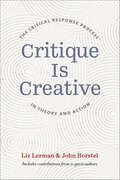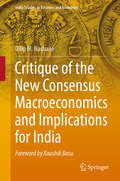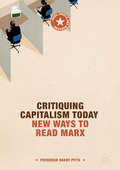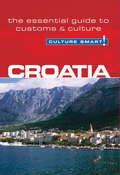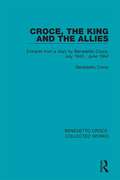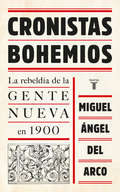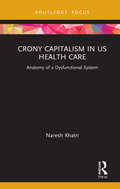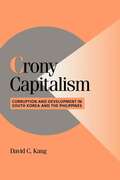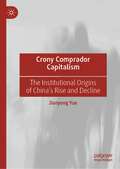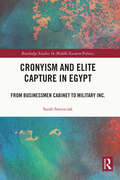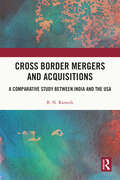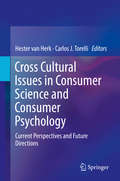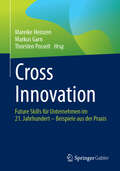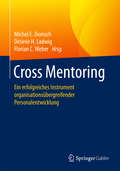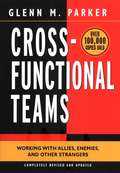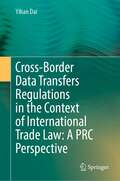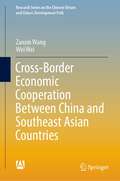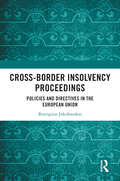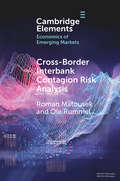- Table View
- List View
Critique Is Creative: The Critical Response Process® in Theory and Action
by Liz Lerman John BorstelWinner of Silver Nautilus for Creativity & Innovation, given by Nautilus Book Award, 2023Devised by choreographer Liz Lerman in 1990, Critical Response Process® (CRP) is an internationally recognized method for giving and getting feedback on creative works in progress. In this first in-depth study of CRP, Lerman and her long-term collaborator John Borstel describe in detail the four-step process, its origins and principles. The book also includes essays on CRP from a wide range of contributors. With insight, ingenuity, and the occasional challenge, these practitioners shed light on the applications and variations of CRP in the contexts of art, education, and community life. Critique Is Creative examines the challenges we face in an era of reckoning and how CRP can aid in change-making of various kinds.With contributions from:Bimbola Akinbola, Mark Callahan, Lawrence Edelson, Isaac Gómez, Rachel Miller Jacobs, Lekelia Jenkins, Elizabeth Johnson Levine, Carlos Lopez-Real, Cristóbal Martínez, Gesel Mason, Cassie Meador, Kevin Ormsby, CJay Philip, Kathryn Prince, Sean Riley, Charles C. Smith, Shula Strassfeld, Phil Stoesz, Gerda van Zelm, Jill Waterhouse, Rebekah West
Critique of the New Consensus Macroeconomics and Implications for India (India Studies in Business and Economics)
by Dilip M. NachaneThe thought-provoking book presents alternative viewpoints to mainstream macroeconomic theory, questions conventional policy wisdom and suggests a systematic re-orientation of current macroeconomic and financial regulatory policies in India.The New Consensus Macroeconomics (NCM), which established itself in the 1980s as mainstream macroeconomics, essentially represents an “uneasy truce” between two dominant schools of economic thought viz. New Classical and Neo-Keynesian economics. The NCM sets the tone for much of the macroeconomic (especially monetary) policy followed by the advanced economies in the period of the Great Moderation (1990–2005). The recent global crisis has posed a major challenge to the NCM as empirical models based on the NCM failed to anticipate the occurrence of the crisis and later its extent and severity. The above considerations constitute the underpinnings of this book, which addresses the theoretical controversies within a general context and their policy implications for India. The authors’ analysis leads to a somewhat critical assessment of the financial sector policies followed in India since the initiation of reforms in 1991. This makes the book a valuable resource not only for researchers working in this area, but also for policy makers.
Critiquing Capitalism Today: New Ways to Read Marx (Marx, Engels, and Marxisms)
by Frederick Harry PittsThis book critically introduces and compares two of the most compelling contemporary schools of Marxist thought: the German Neue Marx-Lekture, or New Reading of Marx, and Italian postoperaismo. In so doing, it radically updates our understanding of the key categories of Marx's critique of political economy- including value, money, labour, class and crisis- in light of new and exciting theoretical developments. The New Reading of Marx reevaluates Marx's Capital in the shadow of the first-generation Frankfurt School, finding an increasing uptake in the Anglophone world. Postoperaismo reconceptualises Marx's work in the wake of the Grundrisse, its theories of immaterial labour and capitalist crisis finding growing favour beyond the radical fringe via recent bestsellers like Paul Mason's Postcapitalism. Drawing on the first to engage in a pathbreaking critique of the second at a time of peak interest in its optimistic prospectus, the book brings into critical dialogue important modern thinkers such as Michael Heinrich, Werner Bonefeld, and Antonio Negri. In so doing, Critiquing Capitalism Today serves as both an introduction to each of these radical reinterpretations of Marx's critique of political economy, and a contribution to continuing debates within and between these and other strands of contemporary Marxism. Advancing knowledge in the field by bridging recent scholarship with older material, including the works of Marx himself, Theodor Adorno and Alfred Sohn-Rethel, it relates theoretical disputes with their historical context in capitalist society itself, keeping an empirical focus that clarifies complex conceptual material for readers new to these cutting-edge currents of critical thought.
Croatia - Culture Smart!: The Essential Guide to Customs & Culture
by Irina BanDon't pack anxiety in your suitcase! By reading Culture Smart! Croatia before you go, will ease your travel, help you to make friends and avoid confusion. Culture Smart! Croatia will help you to understand local manners, customs and laws. Culture Smart! Croatia goes the extra mile to help you brush up on your cultural small talk and will make you confident in leaving your comfort zone far behind. Walk hand in hand with a Culture Smart! guide and avoid misunderstandings that could cost you valuable time, money and enjoyment. . . With Culture Smart! Croatia you will learn about daily living, historical perspectives, taboos, business etiquette, eating and drinking and much more, allowing you to experience the country like a native. Be responsible, be Culture Smart!
Croce, the King and the Allies: Extracts from a diary by Benedetto Croce, July 1943 - June 1944 (Collected Works)
by Benedetto CroceOriginally published in English in 1950 this is one of the most revealing works by one of Italy’s foremost philosophers of the 20th century, who was also a courageous and effective opponent of Fascism. Following the Allied landing at Salerno, Croce was called upon by kings, princes, generals and politicians and asked to decide question of vital importance to Italy. This book records the notes Croce made on political matters in 1943 and 1944 and includes some of the many documents Croce possessed which referred to the attempt in Naples (noted in the Autumn of 1943) to form a Corps of Italian volunteers.
Cronistas bohemios: La rebeldía de la Gente Nueva en 1900
by Miguel Angel del ArcoEl retrato de una época legendaria para la esfera intelectual española y el sector del periodismo, a través de cinco de sus protagonistas. Alrededor de 1900 las redacciones de los periódicos estaban repletas de bohemios que acudían allí para calentarse o para demandar una colaboración. Pero no todos eran hampones y pedigüeños. Entre ellos había literatos de altura que pasaron a la historia como la Gente Nueva y fueron coetáneos, compañeros de café y colegas de modernistas y noventayochistas. Algunos de ellos fueron auténticos pioneros, los primeros corresponsales, cronistas y reporteros, y conformaron los inicios del periodismo moderno. Además de una magnífica contextualización histórica y la descripción de las relaciones entre el periodismo y bohemia de aquel tiempo, Cronistas bohemios reúne algunos de los mejores textos -precedidos de un perfil de cada autor-, excelente muestra de las grandes aportaciones de esta bohemia a la historia del periodismo, esencialmente en el lenguaje (basado en la paradoja y el uso de la palabra como explosivo), el contenido (de calado social) y el humor(a menudo ácido, incluso negro). Los cinco autores aquí reunidos son Antonio Palomero, Alejandro Sawa, Pedro Barrantes, Joaquín Dicenta y Luis Bonafoux, nombres que hoy no representan gran cosa. Sin embargo, estos textos tienen muy poco que envidiar, en calidad, en estilo, en atrevimiento y en novedoso enfoque, a lo que muchos años después conoceríamos como nuevo periodismo. Se pueden leer, hoy mismo, con gusto y asombro. Reseñas:«Además de una magnífica contextualización histórica y la descripción de las relaciones entre periodismo y bohemia de aquel tiempo, Cronistas bohemios reúne algunos de los mejores textos, precedidos de un perfil de cada autor, excelente muestra de las grandes aportaciones de esta bohemia a la historia del periodismo, esencialmente en el lenguaje (basado en la paradoja y el uso de la palabra como explosivo), el contenido (de calado social) y el humor (a menudo ácido, incluso negro).»Todo Literatura «No dejaron huella aparente en el oficio. La Guerra Civil partió en dos el rastro de aquellos hombres en beneficio de una amnesia triunfal que borró su estela. Pero de esos días delirantes quedan sus crónicas y el peso de leyenda que los enclavijó en la bohemia cuando en verdad fueron algo más. En un entorno de sacamantecas, feriantes de café y colmeneros del hambre y la cazalla, dibujaron un periodismo de buen paño que se levantó en los periódicos, en las redacciones de vinagre y ruido, en el fervor de un Madrid sacudido de miseria y sediento de honor, síntomas de una época tremenda y feliz. De una forma de hacer periódicos con el ideal puesto en el último café que cierra más allá de la madrugada.»Antonio Lucas, El Mundo
Crony Capitalism and Economic Growth in Latin America: Theory and Evidence
by Stephen HaberCrony capitalism systems—in which those close to political policymakers receive favors allowing them to earn returns far above market value—are a fundamental feature of the economies of Latin America. Haber and his expert contributors draw from case studies in Mexico, Brazil, and other countries around the world to examine the causes and consequences of cronyism.
Crony Capitalism in India: Establishing Robust Counteractive Institutional Frameworks (Palgrave Studies in Indian Management)
by Naresh Khatri Abhoy OjhaCrony Capitalism in India provides a comprehensive and scholarly examination of the important topic of crony capitalism, filling an important gap in the market. Bringing together experts from various backgrounds, it addresses the key underpinnings of this complex and multifarious issue. Given the emergent nature of the Indian economy, this book provides important information for decision makers in both government and business to help establish a robust institutional framework that is so desperately needed both in India and globally.
Crony Capitalism in US Health Care: Anatomy of a Dysfunctional System (Routledge Focus on Business and Management)
by Naresh KhatriThe US political system has come to depend upon money too much. The US health care industry spends the most on political lobbying among all the 13 industrial sectors in the US economy. The government regulatory agencies at both federal and state levels have been "captured" by the health industry interest groups meaning that the regulatory agencies respond to the interests of the industry but not those of citizens. This book employs a broad theoretical framework of crony capitalism to understand US health care system dysfunction. This framework has not been applied before in any serious manner to understand the shortcomings in the US health care system. Specifically, the book examines the role of seven key players using this framework - politicians/interest groups, pharmaceutical companies, private health insurers, hospitals/hospital networks, physicians, medical device manufacturers, and the American public. Crony capitalism is a destructive force and is rampant in US health care system, causing much waste, inefficiencies, and malaise in the system. Current efforts and initiatives, such as patient-centered medical homes and precision medicine, for improving/reforming the system are of mere academic interest and tantamount to taking aspirin to treat cancer. They do not even pretend to address the root cause of the problem, namely, crony capitalism. Offering prescriptions to fix the U.S. health care system based on a comprehensive diagnosis of the dysfunction, this book will be of interest to researchers, academics, policymakers, and students in the fields of health care management, public and non-profit management, health policy, administration, and economics, and political science.
Crony Capitalism: Corruption and Development in South Korea and the Philippines (Cambridge Studies in Comparative Politics)
by David C. Kang Robert H. Bates Ellen Comisso Peter Lange Joel Migdal Helen MilnerWhy has the literature on Asian development not addressed the issue of money politics in Korea? How can we reconcile the view of an efficient developmental state in Korea before 1997 with reports of massive corruption and inefficiency in that same country in 1998 and 1999? Politics is central to the answer. <p><p>In this book the author makes two arguments. First, both Korea and the Philippines experienced significant corruption throughout the post-independence era. Second, political - not economic - considerations dominated policy making in both countries. Focusing on the exchange of favors for bribes between state and business, the author argues that politics drove policy choices, that bureaucrats were not autonomous from political interference in setting policy, and that business and political elites wrestled with each other over who would reap the rents to be had. Even in Korea, corruption was far greater than the conventional wisdom allows.
Crony Comprador Capitalism: The Institutional Origins of China’s Rise and Decline
by Jianyong YueThis book offers a multidisciplinary redefinition of China's model of crony comprador capitalism. The author argues that this model emerged through the fusion of market Leninism and global capitalism in the early 1990s within the post-Cold War and post-Communist global context. While driving robust export-led growth, this approach hindered China's structural transformation and limited its ascent, ironically leading to the regime's accelerating totalitarian turn and the onset of a new Cold War. In line with the call for ‘Capitalism 3.0,’ the book advocates Western decoupling from China and promoting the country's transition to a democratic developmental state, fostering a safer world for democracy over autocracy. It will be of interest to academics and policy-makers in a wide range of fields, including political economy, political studies, international relations, and economic history.
Cronyism and Elite Capture in Egypt: From Businessmen Cabinet to Military Inc. (Routledge Studies in Middle Eastern Politics)
by Sarah SmierciakExamining business-state networks in Egypt (1991-2020), this book highlights the complicity of international actors in facilitating inequality and elite capture. The interdisciplinary methodology argues that Western actors promoting market liberalization have served as central partners in enabling elites to capture the fruits of Egypt’s economic reforms. In the years leading up to the 2011 Revolution, Egypt’s crony capitalism reached new levels of visibility with the appointment of a "Businessmen Cabinet." The businessmen-turned-state representatives ushered in a wave of "market liberalizing" reforms, expanding avenues for the abuse of power. Providing a detailed look at some of this period’s chief beneficiaries, including a number of Egypt’s wealthiest oligarchs, the volume follows their ascent from former President Hosni Mubarak’s first round of neoliberal reforms in 1991 through his last wave of reforms beginning in 2004 and ending in regime overthrow. The final chapter examines the fate of these elites under the brief rule of Muslim Brotherhood President, Mohammed Morsi, and of Abdel Fattah el Sisi’s current military-backed regime. Based on five years of fieldwork and dozens of interviews with businessmen and state representatives, this book offers a unique look into the politics of policy, and inequality, in Egypt. It will be of interest to scholars reading political economy, international development, and the Middle East studies.
Crook County: Racism and Injustice in America's Largest Criminal Court
by Nicole Gonzalez Van CleveAmericans are slowly waking up to the dire effects of racial profiling, police brutality, and mass incarceration, especially in disadvantaged neighborhoods and communities of color. The criminal courts are the crucial gateway between police action on the street and the processing of primarily black and Latino defendants into jails and prisons. And yet the courts, often portrayed as sacred, impartial institutions, have remained shrouded in secrecy, with the majority of Americans kept in the dark about how they function internally. Crook County bursts open the courthouse doors and enters the hallways, courtrooms, judges' chambers, and attorneys' offices to reveal a world of punishment determined by race, not offense. Nicole Gonzalez Van Cleve spent ten years working in and investigating the largest criminal courthouse in the country, Chicago-Cook County, and based on over 1,000 hours of observation, she takes readers inside our so-called halls of justice to witness the types of everyday racial abuses that fester within the courts, often in plain sight. We watch white courtroom professionals classify and deliberate on the fates of mostly black and Latino defendants while racial abuse and due process violations are encouraged and even seen as justified. Judges fall asleep on the bench. Prosecutors hang out like frat boys in the judges' chambers while the fates of defendants hang in the balance. Public defenders make choices about which defendants they will try to "save" and which they will sacrifice. Sheriff's officers cruelly mock and abuse defendants' family members. Crook County's powerful and at times devastating narratives reveal startling truths about a legal culture steeped in racial abuse. Defendants find themselves thrust into a pernicious legal world where courtroom actors live and breathe racism while simultaneously committing themselves to a colorblind ideal. Van Cleve urges all citizens to take a closer look at the way we do justice in America and to hold our arbiters of justice accountable to the highest standards of equality.
Crosley
by Tom Nicholas David ChenIn October 1941, a top secret envoy from the U.S. military was sent to Crosley Corporation in Cincinnati, Ohio to request their assistance to construct a weapon that would drastically strengthen the defenses of U.S. troops: the proximity fuze. Such a fuze would allow enemy aircraft to be shot down with a rate of accuracy well above that of previous weaponry. The task would be a challenging one, as conventional wisdom held that it took at least four years for a weapon to go from concept to production, whereas the proximity fuze was needed on a shorter time frame. Moreover, the production process would be complex, requiring hundreds of components produced by dozens of manufacturers, all of which Crosley would have to assemble to produce the finished product. Would Crosley accept the assignment?
Cross Border Mergers and Acquisitions: A Comparative Study between India and the USA
by B. N. RameshThis book presents a comparative analysis of cross-border mergers and acquisitions (CBMA) in terms of competitive framework and procedures between India and the United States of America. It discusses themes like statutes, regulations, rulings, legislations and analysis of CBMA; competition law, antitrust, and demerger; new legal initiatives by India like New Economic Policy (NEP), Goods and Services Tax (GST), demonetisation and amendments in the Foreign Exchange Management Act (FEMA); and the impact of COVID on CBMA, to showcase the challenges and opportunities of specific CBMA experience in India in a global framework. This book will be an essential read for scholars and researchers of law, corporate law, company law, international company law, corporate governance, international relations, public policy, international trade law, economics, and for practitioners, policymakers and consultants working on the subject.
Cross Country Group: A Piece of the Rock (A)
by Robert L. Simons Indra A. ReinbergsA new MBA graduate joins a privately held family business and sets ambitious growth goals for the next five years. To enhance motivation, he proposes a new incentive plan that will grant him a share of the wealth he creates. However, the family owners have a more conservative view regarding executive compensation.
Cross Cultural Issues in Consumer Science and Consumer Psychology: Current Perspectives and Future Directions
by Carlos J. Torelli Hester HerkThis integrative volume identifies and defines cross-cultural issues in consumer psychology and consumer science as the world becomes an increasingly global marketplace. An international panel of experts analyzes current trends in consumer behavior across diverse countries worldwide and across cultural groups within countries, depicting commonly-used cross-cultural frameworks and research methods. Beginning with conceptualizing and quantifying culture at the national level, the volume then moves to individual levels of analysis of consumer decision-making, examining consumer data as they affect business decisions in marketing products internationally. The resulting work synthesizes the consumer science, international business, and consumer psychology literatures for a deeper understanding of all three disciplines and pathways to future research as cultures interact and tastes evolve. Among the topics covered: Culture as a driver of individual and national consumer behavior. Consumer culture-based attitudes toward buying foreign versus domestic products. Country-of-origin effects: consumer perceptions of international products. The roles of cultural influences in product branding. Cultural aspects of consumer-brand relationships. Consumer behavior in the emerging marketplace of subsistence countries. This attention to both national detail and individual nuance makes Cross-Cultural Issues in Consumer Science and Consumer Psychology an instructive and highly useful reference for scholars and students in consumer psychology, cross-cultural psychology, marketing, international business, as well as professionals in these areas.
Cross Innovation: Future Skills für Unternehmen im 21. Jahrhundert – Beispiele aus der Praxis
by Mareike Heinzen Thorsten Posselt Markus GarnUnternehmen und ihre Mitarbeitenden stoßen mit geschlossenen Innovations- und Technologieentwicklungssystemen an ihre Grenzen. Heute werden Lösungen oft im Team oder im Netzwerk entwickelt – Cross Innovation etabliert sich als ein wesentlicher Ansatz, der es ermöglicht, die Grenzen bestehender Innovationsökosysteme und Geschäftsmodelle zu überschreiten. So gelingt es Unternehmen, veränderten Bedingungen agil und flexibel zu begegnen, Resilienz in Krisenzeiten zu entwickeln, Transformation und Neuausrichtung in Prozessen, Strukturen oder Denkweisen zu wagen, disruptive Technologien zu integrieren und branchen- und disziplinenübergreifende Innovationen entstehen zu lassen. Wie Cross Innovation erfolgreich praktiziert wird, steht im Mittelpunkt dieses Sammelbandes. Die Plattform für Innovation (PFID) erlaubt durch ihre Vielfalt den Einblick in und den Kontakt zu vielen Ökosystemen, die wir für diesen Band gewinnen konnten: 15 Beiträge aus der Praxis geben einen tiefen Einblick in die Umsetzung, Lessons Learned und Best Practices von Unternehmen und Organisationen. Nicht nur große internationale Konzerne wie Airbus, Bosch, Fraport, KUKA und REWE teilen ihre Erfahrungen, sondern auch kleine und mittlere Unternehmen, wie simatec und BKW Engineering aus der Schweiz oder edding und die Maschinenfabrik Reinhausen aus Deutschland. Ergänzt werden die Praxisbeispiele von Cross-Innovation-Experten, wie dem Cross Innovation Hub Hamburg, dem Institut für Persönlichkeit, der SPRIN-D Agentur sowie dem Fraunhofer Verbund Innovationsforschung, der Hochschule Koblenz und TU Berlin. Cross Innovation ist ein wesentlicher Lösungsschlüssel für die Förderung von Innovation und Wachstum. Dieser Sammelband präsentiert die hierfür notwendigen Future Skills für Unternehmen im 21. Jahrhundert.
Cross Mentoring: Ein erfolgreiches Instrument organisationsübergreifender Personalentwicklung
by Michel E. Domsch Désirée H. Ladwig Florian C. WeberDie Besonderheit dieses Programms zur Personalentwicklung besteht darin, dass Mentor und Mentee nicht aus der gleichen Organisation/dem gleichen Unternehmen kommen. Fundiert und umfassend zeigt dieser Sammelband die breite Vielfalt unterschiedlicher Cross Mentoring Programme auf. Die Bandbreite reicht von Veranstaltern aus der Wirtschaftspraxis und Verb#65533;nden bis zu NGOs und Organisationen aus dem Gesundheitswesen. Der Praxis bietet dieses Werk eine Einsicht in Best-Practices und Hilfestellungen f#65533;r die Entwicklung und Implementierung eigener Cross Mentoring Programme. Die Praxis, Forschung, Lehre und Beratung ziehen Nutzen daraus f#65533;r empirische Projekte, Studien und praxisrelevante eigene Entwicklungen.
Cross- Functional Teams
by Glenn M. ParkerIn this completely revised version of his best-selling book, Cross-Functional Teams: Working with Allies, Enemies, and Strangers, author and consultant Glenn Parker updates his definitive practical guide to include his recent work in team rewards and recognition, communications technology, and multicultural and virtual-team issues. This new edition contains fresh examples and additional case studies of successful cross-functional teams from IBM, Parke-Davis, Xerox, Boeing, BOC Gases, government agencies, and more. Parker offers concrete advice and inspiration to team leaders, team members, and senior management. Cross-Functional Teams delivers a team operating manual to executives, team leaders, human resource professionals, and students of organizational behavior and provides a tool kit of assessment surveys, worksheets, checklists, and even sample training programs to help launch and sustain effective teams.
Cross-Border Data Transfers Regulations in the Context of International Trade Law: A PRC Perspective
by Yihan DaiThis book focuses on the PRC’s cross-border data transfer legislation in recent years, as well as the implications for international trade law. The book addresses the convergence of industries and technologies notably caused by digitization; the issue of conflicts between goods and services; and the General Agreement on Tariffs and Trade (GATT) and General Agreement on Trade in Services (GATS) as well as the difficulty of classifying service sectors under WTO members’ commitments. The book also examines the FTAs that entered into force after 2012 that regulate digital trade beyond the venue of the WTO and analyzes their rules of relevance for cross-border data flows and international trade. It asks whether and how these FTAs have deliberately reacted to the increasing importance of data flows as well as to the trouble of governing them in the context of global governance
Cross-Border Economic Cooperation Between China and Southeast Asian Countries (Research Series on the Chinese Dream and China’s Development Path)
by Wei Wei Zanxin WangThis book focuses on how to promote cross-border economic cooperation in the context of China national strategy including BRI. This book summarizes the existing regional economic development theories and sorts out the relevant theories of cross-border economic cooperation. Then, it analyzes the industrial development of China's southwestern border and neighboring countries, the main reasons of rural household poverty in the border ethnic areas by means of empirical methods, and proposes corresponding policy implications. Also, it explores the current border investment and trade policies of China, and compares the similarities and differences between China and Vietnam, and Laos and Myanmar.
Cross-Border Insolvency Proceedings: Policies and Directives in the European Union
by Remigijus JokubauskasThis book presents an analysis of the effectiveness of European Union cross-border insolvency proceedings. It provides a thorough assessment of the development of cross-border insolvency proceedings established in the Regulation on Insolvency Proceedings ((EU) 2015/848) and how they contribute to the general goals of the EU internal market. Insolvency law has not been subject to a global mandatory harmonization process, with no globally biding legal act. Instead, the landscape of international insolvency law is characterized by a patchwork of national laws that seek to accommodate cross-border insolvencies and soft law agreements. In the EU cross-border insolvency law holds significant importance in ensuring the smooth operation of the internal market. Fostering international investments and legal foreseeability in insolvency proceedings, it upholds the fundamental freedoms within EU law. This book covers the main elements of EU cross-border insolvency law, such as jurisdiction, applicable law, recognition and enforcement of judgments. It also focuses on previously unexplored areas, such as the exercise of creditors' rights in cross-border insolvency cases and the tracing and recovery of assets and discusses the application of the Restructuring and Insolvency Directive ((EU) 2019/1023) in relation to the rescue of viable companies and the discharge of debts for insolvent entrepreneurs. This book will be of interest to students and practitioners of insolvency law, EU law and private international law. It will also be useful for national legislators and EU institutions working on the development of EU insolvency law.
Cross-Border Insolvency: The Enactment and Interpretation of the UNCITRAL Model Law
by Neil HannanThis book examines the effect of the adoption of the United Nations Committee on International Trade Law (UNCITRAL) Model Law on Cross-Border Insolvency in five common law jurisdictions, namely Australia, Canada, New Zealand, the United Kingdom, and the United States of America. It examines how each of those states has adopted, interpreted and applied the provisions of the Model Law, and highlights the effects of inconsistencies by examining jurisprudence in each of these countries, specifically how the Model Law affects existing principles of recognition of insolvency proceedings. The book examines how the UNCITRAL Guide to enactment of the Model Law has affected the interpretation of each of its articles and, in turn, the courts' ability to interpret and hence give effect to the purposes of the Model Law. It also considers the ability of courts to refer to amendments made to the Guide after enactment of the Model Law in a state, thereby questioning whe ther the current inconsistencies in interpretation can be overcome by UNCITRAL amending the Guide.
Cross-Border Interbank Contagion Risk Analysis: Evidence from Selected Emerging and Less-Developed Economies in the Asia-Pacific Region (Elements in the Economics of Emerging Markets)
by Roman Matousek Ole RummelThis Element provides a detailed overview of the structural changes in the Asia-Pacific region from the early 2000s onwards. It reviews the most relevant literature on this important topic. The following two research areas are explored: first, by deploying visual network analysis (VNA), we analyse cross-border interbank claims and liabilities of the individual countries located in the Asia-Pacific region. Such an analysis evaluates interbank exposures to systematically important banks within the specific market. The important advantage of VNA is that it allows us to examine the 'hierarchical' cross-country interbank contagion risk that seems to have been neglected in similar studies. Secondly, we evaluate the contagion risk to the individual countries spreading from the financial centres in Hong Kong, Singapore, Tokyo, New York and London. The analysis unveils links and statistical factors that could be used as a key tool for detecting the potential triggers of systemic risk.
